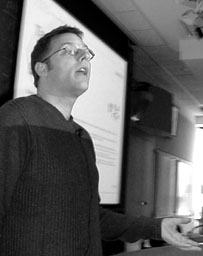Building Computerized Cathedrals for Learning

Art historian, religious scholar, and computer virtuoso, James Moore has always been interested in the lessons that things-inanimate objects, that is-can teach. Now in the fourth year of his doctoral studies at HGSE, he has focused on a quintessentially modern medium: the Internet.
For three years, Moore lived in Europe, where he taught art history by bringing students into museums and cathedrals. The art objects there taught volumes about past societies. Medieval designers crafted Gothic stained-glass windows, for example, to teach parables from the Bible, to provide moral guidance, and to offer examples of social etiquette.
“Every nook and cranny of a Gothic cathedral is meant to represent and teach you something. These people were very visual; they didn’t read,” says Moore, 36, who has master’s degrees in art history and religion from Yale.
After returning from Europe, he found it difficult to teach art history using slide projectors and textbooks. Then he saw Microsoft’s “Art Gallery” CD-ROM. “By today’s standards it’s kind of primitive,” says Moore. “But you could take a painting and turn it around, or show a triptych opening up. I thought, ‘This is what I want to do. I want to figure out how to use this stuff to teach.’”
Moore completed his master’s in the Technology in Education program at HGSE four years ago. He recognized that the Internet, which was just gaining ground, erected barriers as well as bridges to learning. “Learning with other people promotes critical thinking and offers alternative views. The Web can be very distancing,” he says. “If learning is a social endeavor, we must consider ways to support that.”
So Moore programmed public forums-such as chat rooms or message boards-into sites he designed, as a teaching fellow, for several HGSE classes. He discovered that many students shied away from chat rooms and other public venues unless Moore reassured them that neither he nor the professor would “spy” on their conversations.
For the HGSE course he coteaches, Building Web Environments for Education, Moore created a site (at http://studio-edu.net) that respects students’ privacy but facilitates their online discussions. Students can “open” their workspaces so peers can view and comment on works-in-progress; they can “close” their studios to work privately.
For new ideas, Moore watches the business world, which has gone the farthest in researching how people use the Web. Smart sites generate high volume sales by tailoring content to suit individual users. The same concepts might serve educational models, Moore says. “Let’s look at these strategies and think about how we could possibly use them to support learning.”




